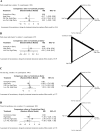Effects of Dairy Intake on Markers of Cardiometabolic Health in Adults: A Systematic Review with Network Meta-Analysis
- PMID: 36914032
- PMCID: PMC10201829
- DOI: 10.1016/j.advnut.2023.03.004
Effects of Dairy Intake on Markers of Cardiometabolic Health in Adults: A Systematic Review with Network Meta-Analysis
Abstract
The health effects of dairy products are still a matter of scientific debate owing to inconsistent findings across trials. Therefore, this systematic review and network meta-analysis (NMA) aimed to compare the effects of different dairy products on markers of cardiometabolic health. A systematic search was conducted in 3 electronic databases [MEDLINE, Cochrane Central Register of Controlled Trials (CENTRAL), and Web of Science; search date: 23 September 2022]. This study included randomized controlled trials (RCTs) with a ≥12-wk intervention comparing any 2 of the eligible interventions [e.g., high dairy (≥3 servings/d or equal amount in grams per day), full-fat dairy, low-fat dairy, naturally fermented milk products, and low dairy/control (0-2 servings/d or usual diet)]. A pairwise meta-analysis and NMA using random-effects model was performed in the frequentist framework for 10 outcomes [body weight, BMI, fat mass, waist circumference, low-density lipoprotein cholesterol, high-density lipoprotein (HDL) cholesterol, triglycerides, fasting glucose, glycated hemoglobin, and systolic blood pressure]. Continuous outcome data were pooled using mean differences (MDs) and dairy interventions ranked using the surface under the cumulative ranking curve. Nineteen RCTs with 1427 participants were included. High-dairy intake (irrespective of fat content) showed no detrimental effects on anthropometric outcomes, blood lipids, and blood pressure. Both low-fat and full-fat dairy improved systolic blood pressure (MD: -5.22 to -7.60 mm Hg; low certainty) but, concomitantly, may impair glycemic control (fasting glucose-MD: 0.31-0.43 mmol/L; glycated hemoglobin-MD: 0.37%-0.47%). Full-fat dairy may increase HDL cholesterol compared with a control diet (MD: 0.26 mmol/L; 95% CI: 0.03, 0.49 mmol/L). Yogurt improved waist circumference (MD: -3.47 cm; 95% CI: -6.92, -0.02 cm; low certainty), triglycerides (MD: -0.38 mmol/L; 95% CI: -0.73, -0.03 mmol/L; low certainty), and HDL cholesterol (MD: 0.19 mmol/L; 95% CI: 0.00, 0.38 mmol/L) compared with milk. In conclusion, our findings indicate that there is little robust evidence that a higher dairy intake has detrimental effects on markers of cardiometabolic health. This review was registered at PROSPERO as CRD42022303198.
Keywords: body weights and measures; cardiometabolic risk; dairy products; energy intake; glycemic control; network meta-analysis; systematic review.
Copyright © 2023 The Author(s). Published by Elsevier Inc. All rights reserved.
Figures




References
-
- Dietary Guidelines Advisory Committee . US Department of Agriculture, Agricultural Research Service; Washington, DC: 2015. Scientific Report of the 2015 Dietary Guidelines Advisory Committee: Advisory Report to the Secretary of Health and Human Services and the Secretary of Agriculture.
-
- Willett W.C., Ludwig D.S. Milk and health. N. Engl. J. Med. 2020;382(7):644–654. - PubMed
Publication types
MeSH terms
Substances
LinkOut - more resources
Full Text Sources
Research Materials
Miscellaneous

